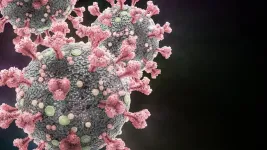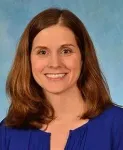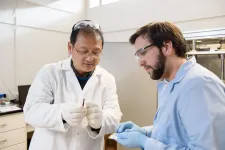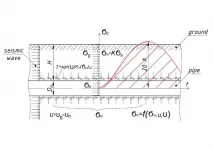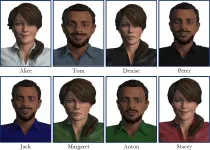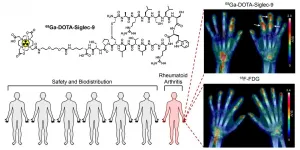(Press-News.org) LA JOLLA, CALIF. - April 16, 2021 - Scientists at Sanford Burnham Prebys have identified a set of human genes that fight SARS-CoV-2 infection, the virus that causes COVID-19. Knowing which genes help control viral infection can greatly assist researchers' understanding of factors that affect disease severity and also suggest possible therapeutic options. The genes in question are related to interferons, the body's frontline virus fighters.
The study was published in the journal Molecular Cell.
"We wanted to gain a better understanding of the cellular response to SARS-CoV-2, including what drives a strong or weak response to infection," says Sumit K. Chanda, Ph.D., professor and director of the Immunity and Pathogenesis Program at Sanford Burnham Prebys and lead author of the study. "We've gained new insights into how the virus exploits the human cells it invades, but we are still searching for its Achille's heel so that we can develop optimal antivirals."
Soon after the start of the pandemic, clinicians found that a weak interferon response to SARS-CoV-2 infection resulted in some of the more severe cases of COVID-19. This knowledge led Chanda and his collaborators to search for the human genes that are triggered by interferons, known as interferon-stimulated genes (ISGs), which act to limit SARS-CoV-2 infection.
Based on knowledge gleaned from SARS-CoV-1, the virus that caused a deadly, but relatively brief, outbreak of disease from 2002 to 2004, and knowing that it was similar to SARS-CoV-2, the investigators were able to develop laboratory experiments to identify the ISGs that control viral replication in COVID-19.
"We found that 65 ISGs controlled SARS-CoV-2 infection, including some that inhibited the virus' ability to enter cells, some that suppressed manufacture of the RNA that is the virus's lifeblood, and a cluster of genes that inhibited assembly of the virus," says Chanda. "What was also of great interest was the fact that some of the ISGs exhibited control across unrelated viruses, such as seasonal flu, West Nile and HIV, which leads to AIDS".
"We identified eight ISGs that inhibited both SARS-CoV-1 and CoV-2 replication in the subcellular compartment responsible for protein packaging, suggesting this vulnerable site could be exploited to clear viral infection," says Laura Martin-Sancho, Ph.D., a senior postdoctoral associate in the Chanda lab and first author of this study. "This is important information, but we still need to learn more about the biology of the virus and investigate if genetic variability within these ISGs correlates with COVID-19 severity."
As a next step, the researchers will look at the biology of SARS-CoV-2 variants that continue to evolve and threaten vaccine efficacy. Martin-Sancho notes that they have already started gathering variants for laboratory investigation,
"It's vitally important that we don't take our foot off the pedal of basic research efforts now that vaccines are helping control the pandemic," concludes Chanda. "We've come so far so fast because of investment in fundamental research at Sanford Burnham Prebys and elsewhere, and our continued efforts will be especially important when, not if, another viral outbreak occurs."
INFORMATION:
Additional study authors include Lars Pache, Anshu P. Gounder, Courtney Nguyen, Yuan Pu, Heather M. Curry, Paul D. De Jesus, Ariel Rodriguez-Frandsen and Xin Yin at Sanford Burnham Prebys. Other authors include Mary K. Lewinski, Charlotte A. Stoneham, Aaron L. Oom, and John Guatelli at the University of California at San Diego and the VA San Diego Healthcare System; Mark Becker, Thomas J. Hope and Judd F. Hultquist at the Northwestern University Feinberg School of Medicine; Dexter Pratt, Christopher Churas, Sara B. Rosenthal, Sophie Liu, Fan Zheng, Max W. Chang, Christopher Benner, Trey Ideker and Alan M. O'Neill at the University of California San Diego; Lisa Miorin, Matthew Urbanowski, Megan L. Shaw and Adolfo García-Sastre at the Icahn School of Medicine at Mount Sinai; Stuart Weston and Matthew B. Frieman at the University of Maryland School of Medicine; and Chunxiang Wu and Yong Xiong at Yale University.
The study's DOI is https://doi.org/10.1016/j.molcel.2021.04.008.
Research reported in this press release was supported by DoD grants W81XWH-20-1-0270; DHIPC: U19 AI118610; and Fluomics/NOSI: U19 AI135972. It was also supported by generous philanthropic donations from Dinah Ruch and Susan & James Blair, from the JPB Foundation, the Open Philanthropy Project (research grant 2020-215611 (5384)) and anonymous donors. Additional support has been provided by DARPA grant HR0011-19-2-0020 and by CRIP (Center for research on Influenza Pathogenesis), a NIAID-funded Center of Excellence for Influenza Research and Surveillance (CEIRS, contract # HHSN272201400008C). This work was additionally supported by the following grants to Northwestern University Feinberg School of Medicine: a CTSA supplement to NCATS: UL1 TR002389; a CTSA supplement to NUCATS with the generous support of the Dixon family: UL1 TR001422; and a Cancer Center supplement: P30 CA060553. Additional support was provided by the following grant to JG at UC San Diego: NIH grant R37AI081668. This work was also supported by a generous grant from the James B. Pendleton Charitable Trust.
The authors declare no competing interests.
About Sanford Burnham Prebys Medical Discovery Institute
Sanford Burnham Prebys is a preeminent, independent biomedical research institute dedicated to understanding human biology and disease and advancing scientific discoveries to profoundly impact human health. For more than 40 years, our research has produced breakthroughs in cancer, neuroscience, immunology and children's diseases, and is anchored by our NCI-designated Cancer Center and advanced drug discovery capabilities. For more information, visit us at SBPdiscovery.org or on Facebook at facebook.com/SBPdiscovery and on Twitter @SBPdiscovery.
Scientists have figured out how to modify CRISPR's basic architecture to extend its reach beyond the genome and into what's known as the epigenome -- proteins and small molecules that latch onto DNA and control when and where genes are switched on or off.
In a paper published April 9, 2021, in the journal Cell, researchers at UC San Francisco and the Whitehead Institute describe a novel CRISPR-based tool called "CRISPRoff," which allows scientists to switch off almost any gene in human cells without making a single edit to the genetic code. The researchers also show that once a gene is switched off, it remains inert in the cell's descendants for hundreds of generations, unless ...
Look deep inside the brain of someone with Alzheimer's disease, most forms of dementia or the concussion-related syndrome known as chronic traumatic encephalopathy (CTE) and you'll find a common suspected culprit: stringy, hairball-like tangles of a protein called tau.
Such conditions, collectively known as "tauopathies" strike scores of people across the globe, with Alzheimer's alone affecting six million people in the United States.
But more than a century after German psychiatrist Alois Alzheimer discovered tau tangles, scientists still have much to ...
What The Study Did: The fitted filtration efficiency of commonly available masks worn singly, doubled or in combinations was evaluated in this study.
Authors: Emily E. Sickbert-Bennett, Ph.D., M.S., of the UNC Medical Center in Chapel Hill, North Carolina, is the corresponding author.
To access the embargoed study: Visit our For The Media website at this link https://media.jamanetwork.com/
(doi:10.1001/jamainternmed.2021.2033)
Editor's Note: The article includes conflict of interest and funding/support disclosures. Please see the article for additional information, including other authors, author contributions and affiliations, conflict of ...
CHAPEL HILL, NC - A study published today in JAMA Internal Medicine shows that wearing two face coverings can nearly double the effectiveness of filtering out SARS-CoV-2-sized particles, preventing them from reaching the wearer's nose and mouth and causing COVID-19. The reason for the enhanced filtration isn't so much adding layers of cloth, but eliminating any gaps or poor-fitting areas of a mask.
"The medical procedure masks are designed to have very good filtration potential based on their material, but the way they fit our faces isn't perfect," said Emily ...
Thermoelectrics directly convert heat into electricity and power a wide array of items -- from NASA's Perseverance rover currently exploring Mars to travel coolers that chill beverages.
A Clemson University physicist has joined forces with collaborators from China and Denmark to create a new and potentially paradigm-shifting high-performance thermoelectric compound.
A material's atomic structure, which is how atoms arrange themselves in space and time, determines its properties. Typically, solids are crystalline or amorphous. In crystals, atoms are in an orderly and symmetrical pattern. Amorphous materials have randomly distributed atoms.
Clemson researcher Jian He and the international team created a new hybrid compound in which the crystalline and ...
Russian scientists have proposed a theory of phase transformation in polymer gels. It explains the mechanisms of the dramatic reduction in volume of zwitterionic hydrogels when they are cooled. The results are published in the journal Chemical Communications (ChemComm).
Polymer gels have unusual properties, including the ability to absorb water in volumes hundreds of times greater than their own. For example, some hydrogels are capable of holding up to two kilograms of water per gram of dry gel. By changing the temperature or adding solvents, various desired properties can be achieved. This is why polymer gels are used in industry and biomedicine, including for the targeted delivery of medication, creation of artificial skin, children's toys, etc.
If you take ...
Two new studies published in Blood suggest that the mRNA COVID-19 vaccine may have reduced efficacy in individuals with chronic lymphocytic leukemia (CLL) and multiple myeloma, two types of blood cancer. According to researchers, these studies could help inform the ideal time for vaccination of these populations.
Study suggests two-dose COVID-19 vaccine is less effective for people with CLL as compared to healthy controls
The first study reports that people with CLL had markedly lower immune response rates to the two-dose mRNA COVID-19 vaccine than healthy individuals ...
Underground pipelines that transport oil and gas are very important engineering communications worldwide. Some of these underground communications are built and operated in earthquake-prone areas.
Seismic safety or seismic stability of underground pipelines began to be intensively studied since the 1950s.
Since then, a number of methodologies were proposed for calculating stress received by an underground pipeline during an earthquake. The purpose of these methodologies was to make an accurate prediction on the structural stress received by a pipeline during an earthquake, and thus it would allow to decide ...
A virtual human can be as good as a flesh-and-blood one when it comes to helping people practice new leadership skills. That's the conclusion from new research published in the journal Frontiers in Virtual Reality that evaluated the effectiveness of computer-generated characters in a training scenario compared to real human role-players in a conventional setting.
Practice-based training techniques, including role-playing, are sometimes used to help improve training outcomes. However, these methods can be expensive to implement, and often require specialized knowledge and even professional actors to create realistic training environments. In addition, some ...
The preliminary trial results of a novel radiopharmaceutical for PET imaging of inflammation developed at the University of Turku, Finland, have been published. The compound, which targets the vascular adhesion protein 1 (VAP-1) that regulates inflammatory cell traffic, is the first radiopharmaceutical that has been developed completely in Finland and has advanced to clinical trials. In the study that started with healthy volunteers, the radiopharmaceutical was found to be well tolerated and safe.
The radiopharmaceutical is 68Ga-labelled Siglec-9 peptide.
"The dose of the radiopharmaceutical ...
